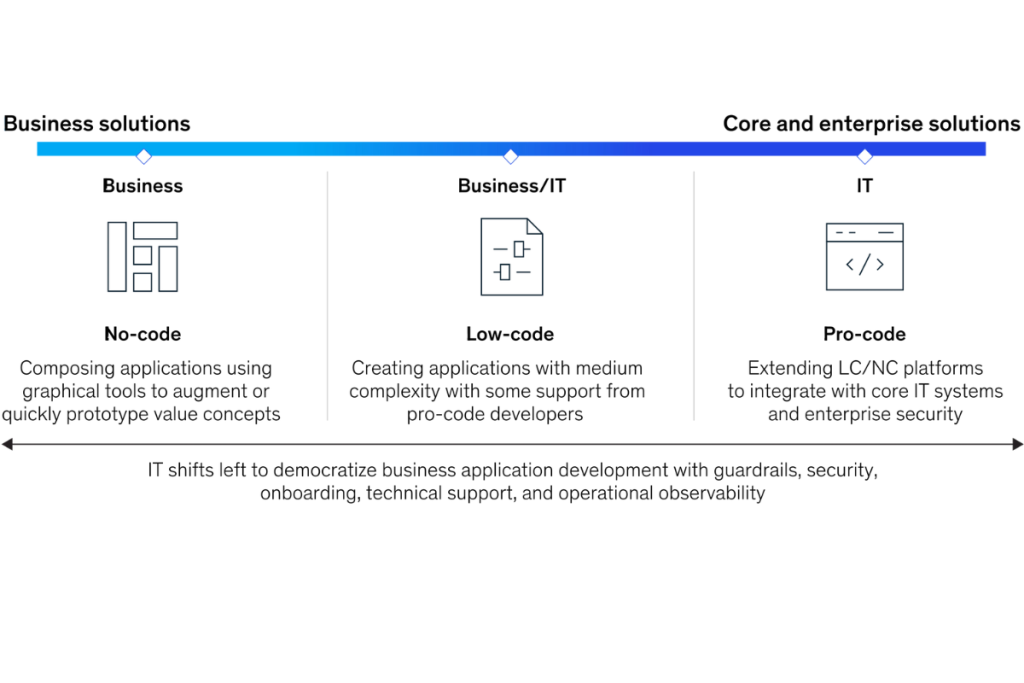
-
Apexlink
Real Estate
-
DLS
General Insurance
-
DMV
Government
-
Entiger
Fintech
-
GIS Mapping
Gas & Petroleum
-
HMS
Employee Benefit
-
HAWA
Government
-
Harley
Community
-
IHG
Hotel & Tourism
-
Sparkseeker
Humane Tech
-
Track Ninja
Sports
-
Response Vision
Disaster Management
- AI/ML Services
- Application Services
- Automation Services
- Cyber Security
- Chatbot Experts
- Data Analysis
- Data Warehouse Services
- Digital Commerce Services
- Digital Transformation
- Infrastructure Service
- Low Code/No Code
- Managed IT Services
- IT Support
- IT Consulting
- IT Outsourcing
- Mobile App Development
- IOS Development
- Android Development
- Cross Platform Development
- Gaming App Development
- Software Development
- System Design & Architecture
- Testing Services
- Web Development
Accelerators
POCs and Products
LCNC development has leapt from the periphery to the center of IT strategy. In fact, 81% of surveyed companies now consider low code strategically important for their business. This reflects a broader shift: as organizations race to digitize and face chronic developer shortages, LCNC platforms let teams innovate much faster and with fewer resources. Instead of viewing them as toy tools, companies are integrating LCNC into their core software roadmaps: today about 31% of firms put low code at the core of how they build applications.
Why Low code/No code Is Now Strategic

Low code (visual development with minimal hand-coding) and no code (entirely visual app-building) tools empower business teams to solve problems without waiting on scarce developers and shorter timelines. Several forces have pushed these tools from the fringe into the strategic mainstream:
1. Talent shortage and demand. The global IT talent gap is acute: in 2020 about 70% of companies couldn’t find the developers they needed. At the same time, demand for new apps keeps skyrocketing. By 2026, it’s estimated that 75% of new applications will be built on low code platforms.
2. Speed-to-market. In today’s fast-moving market, agility matters. Low code platforms can deploy new applications up to 10× faster than traditional methods. Hostinger’s survey notes that enterprise mobile app development is 90% faster with low code platforms. In practice, proof-of-concepts or internal workflow apps that once took months can often be built in weeks. This speed means businesses can pilot ideas quickly, adapt to market changes, or respond to regulatory or customer needs far sooner.
3. Cost and ROI. Along with speed, LCNC often dramatically cuts costs. Research finds low code can slash development costs by up to 50% compared to traditional coding. In longer-term cases, businesses have reported 260% ROI over three years after adopting low code. In short, LCNC delivers tangible ROI, which is why low code adoption is now a multi-billion-dollar market growing rapidly.
4. Democratization of innovation. LCNC platforms unlock tech for the business. By 2026 an estimated 80% of low code users will be outside IT. Departments like marketing, HR or operations can build custom apps (reporting dashboards, simple workflow automations, customer portals) without bottlenecking IT. Early adopters often find that freeing IT from small requests lets developers focus on strategic systems, while business units move ahead on their priorities. According to research, 90% of developers report that low code helps manage their backlog, because routine needs are offloaded to citizen builders.
Taken together, these drivers explain the strategic re-think: organizations can no longer treat low code as a gimmick. It’s now a core enabler of digital transformation. Leaders are recognizing that to stay competitive, they must leverage these platforms alongside traditional coding.
Balancing Rapid Deployment with Governance
Of course, speed and cost savings only materialize if low code is used smartly. As experts caution, when an agency provides multiple low code platforms without a roadmap, the results are often counterproductive. You can end up with duplicated apps, poor integration, ballooning licenses, and even security gaps. In other words, unmanaged LCNC is like shadow IT on steroids.
To integrate low code into a digital strategy while protecting long-term value, organizations should adopt best practices:

1. Establish Clear Governance. Treat low code adoption like a cloud initiative. Define standards for which platform features to use and how apps should interoperate. Set up a central governance team or COE (center of excellence) that vets new projects, maintains templates, and enforces security/compliance rules. CGI advises agencies to borrow from [their] cloud adoption playbooks and build a low code development governance plan as part of the overall digital strategy. This ensures speed doesn’t sacrifice control.
2. Inventory and Standardize Tools. Keep a list of all the low-code and no-code platforms you use and explain why you need licenses for them. Before implementing a new tool, consider the vendor's track record, security certifications, and integration capabilities.
Choose platforms that offer current architectures (APIs, cloud-native deployment, and CI/CD pipelines) so that low-code apps can integrate with enterprise systems. During that period, seek to focus on a few strategic platforms rather than dozens of specialist solutions.
3. Involve IT and Business Together. Ensure IT architects work with business teams from the start. Define which projects are suitable for citizen developers and which need full engineering. Provide training and sandboxes so non-IT users can innovate safely. This collaboration model lets LCNC accelerate delivery with IT alignment, rather than creating isolated silos.
4. Reuse and Scale Proven Apps. Encourage reuse of components and templates. If one department builds a useful workflow on low code, make that template available company-wide. Over time, develop a library of proven modules. Reusing code speeds up future projects and improves quality, reinforcing that low code solutions are enterprise-grade.
5. Measure and iterate. Low code, like every strategic effort, requires key performance indicators (KPIs) and feedback loops. Monitor KPIs like as time-to-market for new apps, reduction in IT backlog, user happiness, and cost-per-project. Monitor the platform's performance on a regular basis to ensure that it is meeting its commitments. This data-driven approach focuses on business outcomes.

By following such steps, leaders balance the draw of rapid delivery with the discipline of long-term planning. Over time, CIOs should integrate low code into their architecture strategy, defining enterprise data models, building API layers, and establishing update and upgrade policies so that quick wins become sustainable assets.

Measuring ROI and Planning Ahead
A key question executives ask is, What’s the ROI and sustainability of this approach? The good news: low code often pays off quickly. As noted, many companies break even within a year or two. Long-term studies show cumulative gains - businesses have reported an increased return on investment over three years after adopting low code, driven by faster launches and increased automation.
However, high Low code ROI relies on ongoing governance and reuse. Without oversight, the benefits can fizzle. Organizations should keep improving their Low code/No code Strategy just as they would for any major technology. This includes regularly reviewing platforms, updating old apps to newer systems, and making sure training keeps up with the latest tools.
Importantly, ROI isn’t just about development costs. Consider the value of reduced cycle time (getting products to market faster), improved customer experience (modernizing interfaces), and even employee productivity (automating internal processes). These factors compound over time. Many CXOs now view low code as vital for transformation projects, because it boosts agility and frees IT capacity. Tracking a mix of financial metrics and operational metrics will give a full picture of value.
The understanding is to keep low code/no code as a key part of digital strategy. That means dedicating resources to it, setting explicit goals and aligning it with broader initiatives like cloud migration or AI. When done right, the payoff is huge: faster innovation today, and a platform that scales for tomorrow.

Conclusion
Low code/no code platforms have crossed the threshold from nice-to-have to strategic imperative. With 81% of leaders recognizing their importance, LCNC is now important to how enterprises innovate. By utilizing these tools with a clear roadmap, robust governance, and ROI-minded planning, organizations can harness their speed without losing sight of long-term goals. The result is a dual win, rapid deployment of new digital capabilities and a sustainable, high-return strategy for the years ahead.
Frequently Asked Questions
1. Can low code/no code really reduce development costs?
Yes, Low Code/No Code development significantly cuts costs by minimizing manual coding, speeding up delivery, and reducing reliance on large development teams key advantages in any Agile Digital Strategy.
2. Is low code/no code only for simple apps?
Not at all. While ideal for simple solutions, Low Code/No Code platforms now support complex Mobile Application Development and enterprise-grade apps as part of broader Digital Transformation efforts.
3. What industries benefit most from low code/no code platforms?
Industries like healthcare, finance, retail, and logistics benefit most, using Low Code/No Code Strategy for process automation, customer portals, and Rapid Application Delivery in fast-changing markets.
4. How does low code/no code integrate with AI initiatives?
Low Code/No Code development integrates AI through pre-built components and APIs, enabling faster deployment of intelligent apps supporting data-driven innovation and smarter Digital Transformation at scale.







 Blockchain
Blockchain Cloud Computing
Cloud Computing Infrastructure
Services
Infrastructure
Services Metaverse
Metaverse QA
Automation
QA
Automation UI/UX
UI/UX







